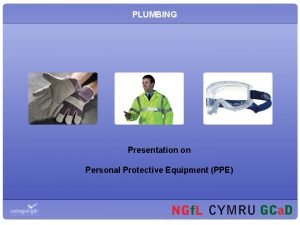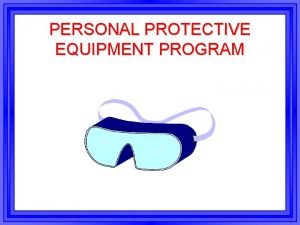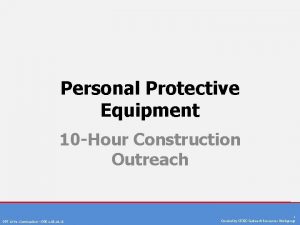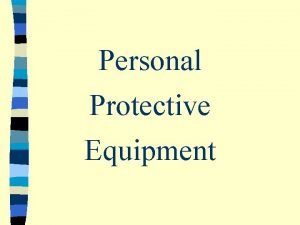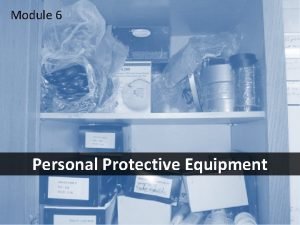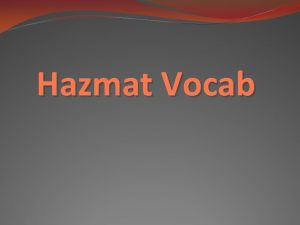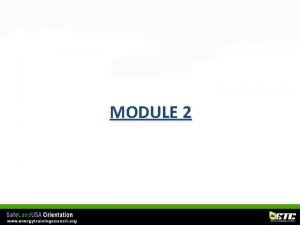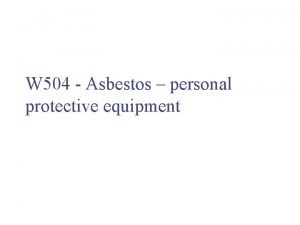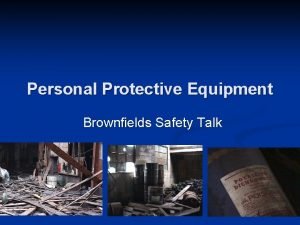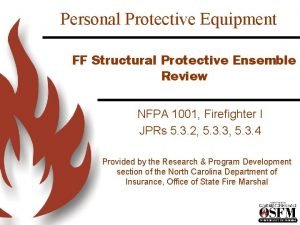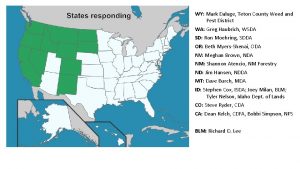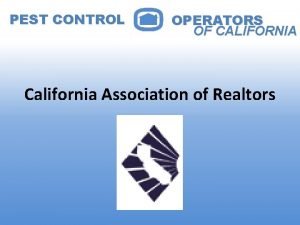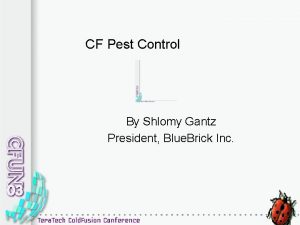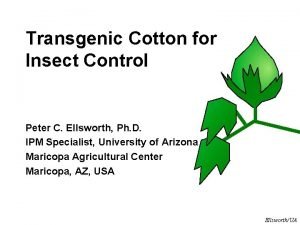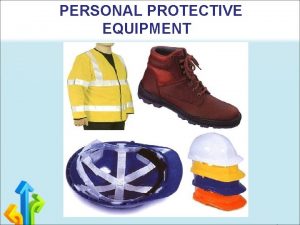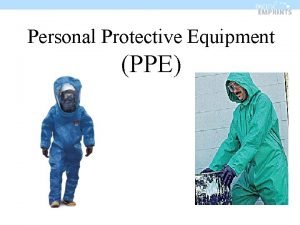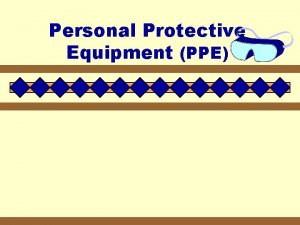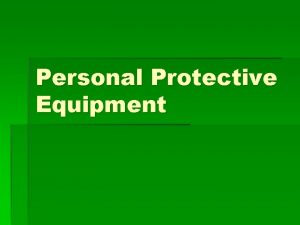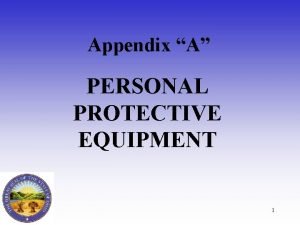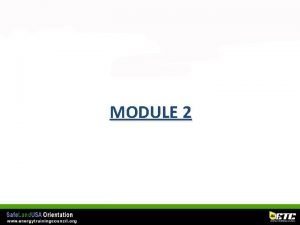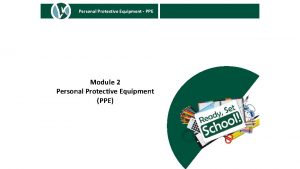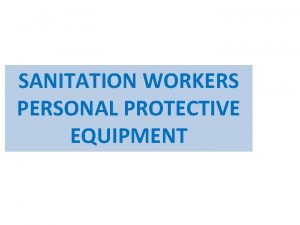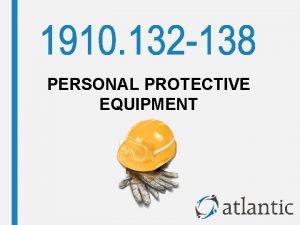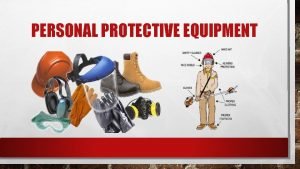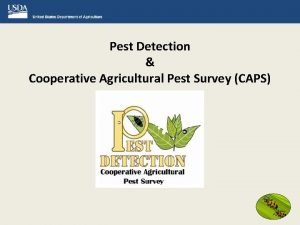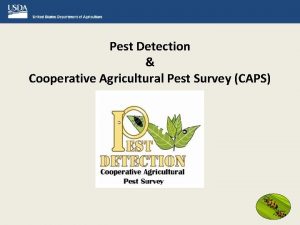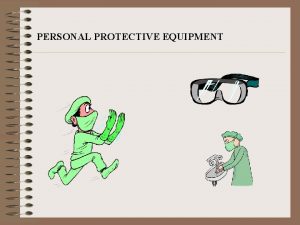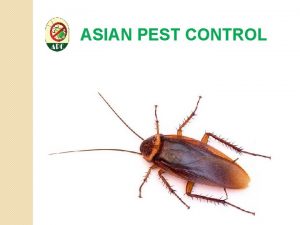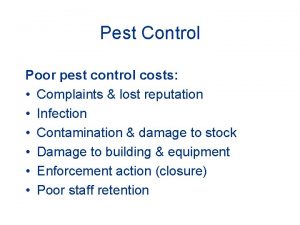Personal Protective Equipment for the Pest Control Technician


























- Slides: 26

Personal Protective Equipment for the Pest Control Technician Eyes, Hands, and Head Protection

Common Causes of Eye Injuries § Flying objects § Particles, dust and debris § Chemical (powders and liquid) § Protruding nails, screws or wires § Trees and shrubs

Best Defense Against Eye Injury § § Know the dangers Eliminate the hazard(s) Read label and SDS Avoid pouring and mixing in the wind § Determine eye protection needed by considering: § Type of work being done § Specific areas or environments § Required by Label or SDS

Eye Protection – Safety Glasses Protect from flying particulates and chemical splashes Use during: q Inspections q Treatments q Mixing & Handling q Operating Gas Auger or other handheld tools

Eye Protection - Goggles Necessary for any task which could result in an impact/splash to the eye Required to be worn over prescription glasses if safety glasses do not fit over the frame Use when handling chemicals or for hazardous work that safety glasses cannot mitigate (heavy debris situations such as removing ceiling tiles, blowing insulation, etc. )

Eye Protection – Face Shield Full face protection from splashes or impacts q Use for grinding, spraying or splashing q Mosquito control and upper perimeter treatments q

Eye Protection - Evaluate q To determine if other protective equipment is necessary REMEMBER: Always evaluate the task you are about to perform to determine what additional PPE equipment is necessary.

Your Hands § Button your shirt § Pour a cup of coffee § Eat with a spoon or fork § Dial and use the phone § Use hand tools § Operate machinery An injury to your hands can be debilitating.

Hand Injuries § 25% of disabling workplace injuries involve the hands. § Common injuries include: § Cuts § Burns § Fractures § Skin irritations § Amputations

Hand Protection Knives, E e v i s s xce Sharp E dges, Sp io t a r b Vi linters n Blood & Bodily Fluids ty i c i r t c e El Hot O bjects Extreme Cold

Hand Protection in Pest Control Nitrile chemical resistant gloves prevent contact with products. Leather gloves protect your hands from rough surfaces.

Glove Limitations § § § Gloves can get caught in moving machinery. Some people may be allergic to some glove materials. Chemicals can get inside the gloves and cause irritation. § Gloves can fail in extreme conditions. § Gloves don’t last forever. § Dexterity may be limited § Proper fit is essential

Glove Size & Fit Too big A better fit

Glove Use & Care § Gloves must fit properly. § Hands should be clean. § Clean fabric and leather gloves regularly. § Inspect gloves for damage and replace if necessary.

Glove Use & Care § Gloves should be the right type for the job. § Do not use fabric or leather gloves with liquid chemicals § Remove gloves before touching other items

Inspection § Signs of chemical degradation § Swelling § Cracking § Shrinking § Discoloration of material § Holes § Punctures § Cleanliness § Correct size Refer to manufacturer’s information on packaging for complete care and maintenance.

Contaminated Gloves Watch video Remove contaminated gloves safely and properly.

Review § Gloves must fit properly § Inspect gloves for damage and replace if necessary § Gloves should be the right type for the job § Do not use fabric or leather gloves with liquid chemicals § Remove gloves before touching other items § Gloves don’t last forever § Don’t take your hands for granted

Head Protection Hard Hat and Bump Cap

Head Protection at Cook’s Bump Cap Hard Hat WARNING: These two caps have very different applications. You can never substitute a bump cap for a hard hat.

Visually Inspect the Shell for: Inspection q Cracks, nicks q Holes and dents q Loss of surface gloss q Other signs of wear

Inspection Visually Inspect Suspension for: q Cracks or tears q Frayed or cut straps q Loss of flexibility q Other signs of wear

Maintenance and Care of Head Protection o Clean the shell and suspension system o Inspect the shell for any signs of damage o Inspect suspension straps o Do not use adhesive, or cleaning solvents o Never drill holes in the shell o Do not paint or place stickers on the shell o Store away from extreme temperatures or direct sunlight

Replacement of Head Protection • Cracks appear in shell • Shiny surface appears dull or chalky • Shell or suspension becomes brittle • The suspension will no longer hold securely • If it has been struck • Remove and destroy any head protection if it’s protective abilities are in doubt. ”

Key Points to Remember • Inspect head protection prior to each use • Periodically clean head protection • Store head protection away from extreme heat or direct sunlight • Altering head protection is prohibited • Wear the correct type of head protection for the hazards found • Remove and destroy any head protection if it’s protective abilities are in doubt. ”

Discussion time Be sure to have each participant complete the quiz questions on slide 19 and 27.
 Plumbing presentation
Plumbing presentation Personal protective equipment program
Personal protective equipment program Who is responsible for providing specialized work footwear?
Who is responsible for providing specialized work footwear? Chapter 2 safety in welding
Chapter 2 safety in welding Objectives of ppe
Objectives of ppe Personal protective equipment for farmers
Personal protective equipment for farmers 6 personal protective equipment
6 personal protective equipment Personal protective equipment in chemistry laboratory
Personal protective equipment in chemistry laboratory Personal protective equipment vocabulary
Personal protective equipment vocabulary Summary of personal protective equipment
Summary of personal protective equipment Personal protective equipment pictograms
Personal protective equipment pictograms Ppe matrix doc
Ppe matrix doc Asbestos personal protective equipment
Asbestos personal protective equipment Plumbing ppe
Plumbing ppe Personal protective equipment safety talk
Personal protective equipment safety talk Droplet precautions ppe
Droplet precautions ppe Special protective equipment used in firefighting except
Special protective equipment used in firefighting except Weed control teton county
Weed control teton county Cover crops
Cover crops Pest control herron
Pest control herron Pest control operators of california
Pest control operators of california Pest control docker
Pest control docker Pest control alison
Pest control alison Debugger pest control
Debugger pest control Adaptive pest control
Adaptive pest control Cottons pest control
Cottons pest control Unconcentration
Unconcentration
